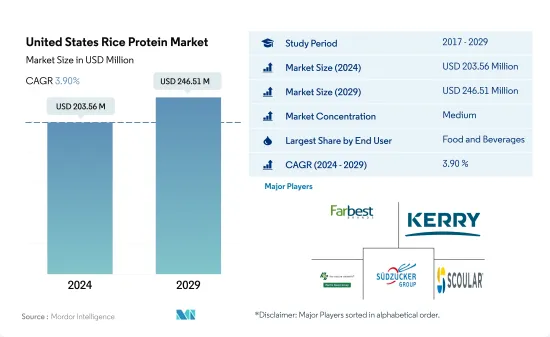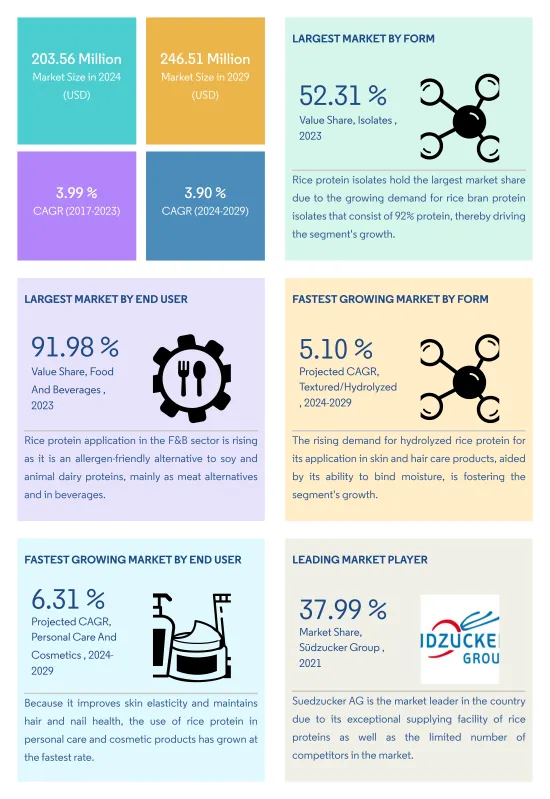Need help finding what you are looking for?
Contact Us
PUBLISHER: Mordor Intelligence | PRODUCT CODE: 1430636

PUBLISHER: Mordor Intelligence | PRODUCT CODE: 1430636
United States Rice Protein - Market Share Analysis, Industry Trends & Statistics, Growth Forecasts (2024 - 2029)
PUBLISHED:
PAGES: 167 Pages
DELIVERY TIME: 2-3 business days
SELECT AN OPTION
The United States Rice Protein Market size is estimated at USD 203.56 million in 2024, and is expected to reach USD 246.51 million by 2029, growing at a CAGR of 3.9% during the forecast period (2024-2029).


Growing lactose-intolerant population in the country and increasing protein consumption need is driving the use of rice protein
- Rice proteins witnessed maximum demand in the food and beverage segment, majorly led by meat/poultry/seafood and meat alternative products. In 2022, the sub-segment claimed more than 83% of rice proteins consumed in the country. Rice protein satiates multiple consumer demands, such as vegan, gluten-free, and high-protein food products. Rice proteins were used as meat extenders at different concentration levels (3%, 6%, 9%, and 12%) for the development of chicken nuggets. The segment for baking supplies and baking mixes may have extremely high demand as a result of the protein trend, which is only expected to intensify. To meet the growing demand for vegan bakery products, food producers are using rice protein to create protein-rich bakery items.
- The ingredient is gaining popularity for being hypoallergenic and a nutritious alternative for people dealing with lactose intolerance. The number of lactose-intolerant people in the country is around 30 million, leading to high demand for alternative proteins, including rice protein. Especially rice-based formulas have been used as a better alternative than soy milk for children with cow's milk allergy, as the human digestibility of polished rice protein is as high as 86-90%.
- In terms of growth, the personal care and cosmetics segment is set to outpace major categories in terms of growth, with a projected CAGR of 6.18% by value during the forecast period. This growth can be attributed to the rising demand for synthetic ingredients in beauty products. Consumers are increasingly embracing plant-based substitutes such as rice proteins, thus leading to market expansion.

United States Rice Protein Market Trends
Plant protein consumption growth fuels opportunities for key players in the ingredients sector
- The per capita consumption rate of plant proteins is increasing at a considerable rate in the United States, supported by investments and innovations, resulting in a consumption rate of 40.28 grams per day, primarily due to a rising number of consumers turning vegan to promote animal welfare. This is because factory farming, where animals are maltreated, is a norm in the United States. Most Americans eat less meat and animal products, but they do not eliminate their consumption entirely. They also tend to be more flexitarian than vegan or vegetarian. Nearly 12% of consumers in the country prefer a plant-based diet, whereas 7% of consumers follow a flexitarian diet. Although consumers of all generations in the United States are interested in plant-based meals, individuals in their 20s and 30s are the keenest to adopt plant-based diets.
- There is a constant rise in the per capita consumption of pea protein due to its wide applications in different food products, like meat, poultry, and bakery products. Around 41% of consumers are interested in plant-based food derived from pea protein. The usage of pea protein is mainly observed in sports nutrition and meal replacement applications. A typical serving of pea protein powder is 30 grams, with 25 grams of protein recommended to consumers.
- Soy and whey proteins are used primarily in the food and beverage, supplement, and sports nutrition industries. In 2021, around 36% of consumers were familiar with soy protein and had consumed the same, whereas 31% of individuals consumed whey protein in the United States. Similarly, the consumption of soy-based food and beverages favorably increased by 12.9% during 2014-2019, and it is likely to remain consistent throughout the forecast period.

Increase in rice production to support rice protein processors
- There is a trend of changing dietary preferences globally and a low inclination among US consumers toward meat-based products. The growing percentage of consumers becoming more flexitarian or vegan is offering enough opportunities for manufacturers to introduce and innovate in the plant protein segment. As of 2021, nearly 6% of the total population was vegan in the United States.
- Rice protein isolates and concentrates are increasingly being produced from rice bran. Also, functional foods, particularly dietary supplements, are emerging as one of the largest application areas of rice protein, as manufacturers are embracing the blending approach for plant protein-based products. The United States is a timely supplier of high-quality rice in both the long and combined medium and short-grain global market, accounting for less than 2% of the global rice production. Since 2019/20, the United States has imported more than 13% of its entire rice supply, up from 10% from 2014/15 to 2018/19. In terms of export, India is the top exporter of rice, accounting for over 46% of the country, i.e., more than 21 million ton in 2021.
- In 2021, the United States produced 191.8 million hundredweight (CWT) of rice, down 16% from 2020 but still slightly above the 2019 crop. In the United States, long-grain production accounts for 75% of rice production, medium-grain production for 24%, and short-grain for the remainder. There is likely to be increased adoption of rice protein in various industries, such as the pharmaceutical industry (for therapeutic proteins or peptides), the animal feed industry (for poultry and other animals), and the cosmetics industry (for cosmetic and personal care products).

United States Rice Protein Industry Overview
The United States Rice Protein Market is moderately consolidated, with the top five companies occupying 60.90%. The major players in this market are Farbest-Tallman Foods Corporation, Kerry Group PLC, MB-Holding GmbH & Co. KG, Sudzucker Group and The Scoular Company (sorted alphabetically).
Additional Benefits:
- The market estimate (ME) sheet in Excel format
- 3 months of analyst support
Product Code: 90072
TABLE OF CONTENTS
1 EXECUTIVE SUMMARY & KEY FINDINGS
2 INTRODUCTION
- 2.1 Study Assumptions & Market Definition
- 2.2 Scope of the Study
- 2.3 Research Methodology
3 KEY INDUSTRY TRENDS
- 3.1 End User Market Volume
- 3.1.1 Baby Food and Infant Formula
- 3.1.2 Bakery
- 3.1.3 Beverages
- 3.1.4 Breakfast Cereals
- 3.1.5 Condiments/Sauces
- 3.1.6 Confectionery
- 3.1.7 Dairy and Dairy Alternative Products
- 3.1.8 Elderly Nutrition and Medical Nutrition
- 3.1.9 Meat/Poultry/Seafood and Meat Alternative Products
- 3.1.10 RTE/RTC Food Products
- 3.1.11 Snacks
- 3.1.12 Sport/Performance Nutrition
- 3.1.13 Animal Feed
- 3.1.14 Personal Care and Cosmetics
- 3.2 Protein Consumption Trends
- 3.2.1 Plant
- 3.3 Production Trends
- 3.3.1 Plant
- 3.4 Regulatory Framework
- 3.4.1 United States
- 3.5 Value Chain & Distribution Channel Analysis
4 MARKET SEGMENTATION (includes market size in Value in USD and Volume, Forecasts up to 2029 and analysis of growth prospects)
- 4.1 Form
- 4.1.1 Concentrates
- 4.1.2 Isolates
- 4.1.3 Textured/Hydrolyzed
- 4.2 End User
- 4.2.1 Food and Beverages
- 4.2.1.1 By Sub End User
- 4.2.1.1.1 Bakery
- 4.2.1.1.2 Beverages
- 4.2.1.1.3 Meat/Poultry/Seafood and Meat Alternative Products
- 4.2.1.1.4 Snacks
- 4.2.2 Personal Care and Cosmetics
- 4.2.3 Supplements
- 4.2.3.1 By Sub End User
- 4.2.3.1.1 Elderly Nutrition and Medical Nutrition
- 4.2.3.1.2 Sport/Performance Nutrition
- 4.2.1 Food and Beverages
5 COMPETITIVE LANDSCAPE
- 5.1 Key Strategic Moves
- 5.2 Market Share Analysis
- 5.3 Company Landscape
- 5.4 Company Profiles (includes Global Level Overview, Market Level Overview, Core Business Segments, Financials, Headcount, Key Information, Market Rank, Market Share, Products and Services, and Analysis of Recent Developments).
- 5.4.1 Axiom Foods Inc.
- 5.4.2 Farbest-Tallman Foods Corporation
- 5.4.3 Green Source Organics
- 5.4.4 Kerry Group PLC
- 5.4.5 MB-Holding GmbH & Co. KG
- 5.4.6 Sweet Additions LLC
- 5.4.7 Sudzucker Group
- 5.4.8 The Scoular Company
6 KEY STRATEGIC QUESTIONS FOR PROTEIN INGREDIENTS INDUSTRY CEOS
7 APPENDIX
- 7.1 Global Overview
- 7.1.1 Overview
- 7.1.2 Porter's Five Forces Framework
- 7.1.3 Global Value Chain Analysis
- 7.1.4 Market Dynamics (DROs)
- 7.2 Sources & References
- 7.3 List of Tables & Figures
- 7.4 Primary Insights
- 7.5 Data Pack
- 7.6 Glossary of Terms
Have a question?


SELECT AN OPTION
Have a question?


Questions? Please give us a call or visit the contact form.
